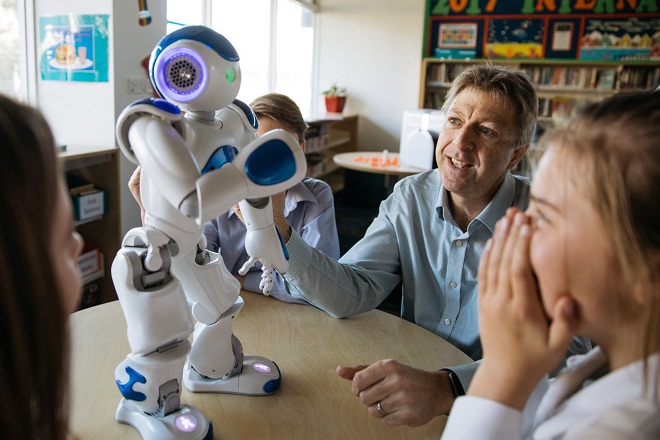When many of us think of robots, our minds turn to Hollywood characters, the likes of famous Star Wars pair R2-D2 and C-3PO or Disney’s WALL-E. So, from the movie screen to the classroom, how can robots assist in students’ learning?
As coding becomes an increasingly mainstream skill, robots are helping students to learn in new ways and establish the skills of the future.
Year 4 and 7 students at SPW were recently introduced to the world of coding, welcoming Thomas – a humanoid robot – into their classrooms.
As Geoff Bilney, Head of Future Schooling at SPW, explained coding is an area of learning that is being encouraged across almost all educational jurisdictions.
“At SPW one of our strategic goals is to become a school of the future and one way to achieve this is by steadily introducing coding and programming into units of work,” he said.
“I think students also realise that education is changing.”
SPW Year 4 teachers, Lynn Lee and Cathy Kowalick, and Year 7 teacher, Fleur Kennedy, share their top four takeaways from teaching and learning with Thomas.
1. More than curriculum – it’s life skills
Thomas was initially integrated as part of the Year 4 and 7 science and mathematics classes. The Year 7s used Thomas to practice their fractions, while they also buddied with the Year 4s to create a program that tested the younger students’ knowledge of different animal groups.
However, it was soon discovered that learning with Thomas went further than the curriculum and technical skills needed in the coding program, ‘Choreographe’.
Lynn said working with Thomas highlighted the need for character skills – creativity, problem solving, risk taking, communicating, logical thinking, resilience, teamwork and patience.
“The character skills required in coding are transferable to so many aspects of the children’s lives.”
Fleur said patience and problem solving played a huge part of working with Thomas.
“There was one day where we couldn’t work how to code yes or no answers. Geoff came down – and he didn’t know the answer. In the end the kids worked it out. It turned out that all the lessons I have done around capital letters weren’t needed in this scenario! To represent yes, the coding was a lowercase ‘y’. The same with no, you needed a lowercase ‘n’,” she said.
“It was great to see the students work it out themselves and for them to experience intrinsic motivation of ‘you just keep going until you solve the problem’. When they solved the problem they experienced a feeling of pride and success. It wasn’t a medal or chocolate, it was just knowing they had achieved it.”
2. A difference in interaction
While the younger students felt empathy for Thomas as a character and wanted to sit and cuddle him, the older students were interested in exploring his capabilities – especially the boys.
Cathy said the Year 4 students personified Thomas, seeing him as a person – not a computer.
“The students knew that he had a ‘sister’ Pink. She was at another school and they wondered if he was going to miss her,” she said.
Fleur said the older girls tended to be more apprehensive and were very cautious when they went near Thomas, whereas the boys wanted to push him to complete more challenging movements.
“I think this is because the boys have been exposed to elements of coding in the video and computer games they play,” she said.
3. Learning side-by-side
Lynn said a major difference in bringing Thomas into the classroom, was having students and teachers learning together.
“Before introducing Thomas to the students we learnt how to use ‘Choreographe’ – but we definitely didn’t have all the answers,” she said.
“To be honest, it was daunting not knowing why something wasn’t working, but it was about having confidence as a teacher and encouraging your kids to have a go.”
“You would see the clock ticking down and it’s a jam-packed curriculum that you want to get through – so those were definitely the pressures of being the teacher. But it was all worth it when you saw the children getting so much out of it and the array of skills they came out with at the end.”
4. The students who surprise you
Cathy said the highlight of introducing Thomas in the classroom was the individual success stories, where the kids who normally shy away from learning had their chance to shine.
“With Thomas, there is definitely less explicit instruction. The lesson structure is more hands-on. This is perhaps why it engages some of the students who aren’t so absorbed when it comes to bookwork.
“One of my students is a very tactile person. He loves hands-on projects and something he can manipulate, compared to reading and writing, which can be quite difficult for him.”
“He absolutely shone with Thomas and he was definitely our total expert – students would call him over and ask for his help. It fostered his self-esteem, made him feel needed and gave him a very special role in the program.”
As a member of Association of Independent Schools SA (AISSA), SPW was successful in a grant application to have Thomas at the school for Term 2 and 3.